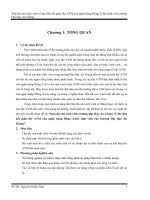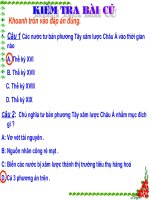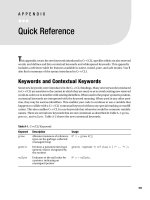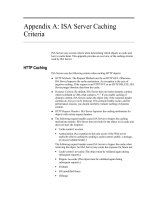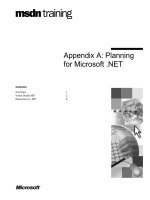Appendix A The Preprocessor
Bạn đang xem bản rút gọn của tài liệu. Xem và tải ngay bản đầy đủ của tài liệu tại đây (458.53 KB, 11 trang )
1
C++ A Beginner’s Guide by Herbert Schildt
Appendix A
The Preprocessor
The preprocessor is that part of the compiler that performs various text manipulations on your program
prior to the actual translation of your source code into object code. You can give text manipulation
commands to the preprocessor. These commands are called preprocessor directives, and although not
technically part of the C++ language, they expand the scope of its programming environment.
The preprocessor is a holdover from C and is not as important to C++ as it is to C. Also, some
preprocessor features have been rendered redundant by newer and better C++ language elements.
However, since many programmers still use the preprocessor, and because it is still part of the C++
language environment, it is briefly discussed here.
The C++ preprocessor contains the following directives:
As is apparent, all preprocessor directives begin with a # sign. Each will be examined here in turn.
#define
#define is used to define an identifier and a character sequence that will be substituted for the identifier
each time it is encountered in the source file. The identifier is called a macro name, and the replacement
process is called macro substitution. The general form of the directive is
#define macro-name character-sequence
Notice that there is no semicolon in this statement. There can be any number of spaces between the
identifier and the start of the character sequence, but once the sequence begins, it is terminated only by
a newline.
For example, if you wanted to use the word “UP” for the value 1 and the word “DOWN” for the value 0,
you would declare these two #defines:
#define UP 1 #define DOWN 0
These statements will cause the compiler to substitute a 1 or a 0 each time the name UP or DOWN is
encountered in your source file. For example, the following will print 102 on the screen:
2
C++ A Beginner’s Guide by Herbert Schildt
It is important to understand that the macro substitution is simply the replacing of an identifier with its
associated string. Therefore, if you want to define a standard message, you might write something like
this:
#define GETFILE "Enter File Name" // ... cout << GETFILE;
C++ will substitute the string “Enter File Name” when the macro name GETFILE is encountered. To the
compiler, the cout statement will actually appear to be
cout << "Enter File Name";
No text substitutions will occur if the macro name occurs within a quoted string. For example,
#define GETFILE "Enter File Name"
// ...
cout << "GETFILE is a macro name\n";
will not print
Enter File Name is a macro name
but rather will print
GETFILE is a macro name
If the string is longer than one line, you can continue it on the next by placing a backslash at the end of
the line, as shown in this example:
#define LONG_STRING "this is a very long \ string that is used as an example"
It is common practice among C++ programmers to use capital letters for macro names. This convention
helps anyone reading the program know at a glance that a macro substitution will take place. Also, it is
best to put all #defines at the start of the file, or perhaps in a separate include file, rather than sprinkling
them throughout the program.
One last point: C++ provides a better way of defining constants than by using #define. This is to use the
const specifier. However, many C++ programmers migrated from C, where #define is commonly used for
this purpose. Thus, you will likely see it frequently in C++ code, too.
Function-Like Macros
The #define directive has another feature: The macro name can have arguments. Each time the macro
name is encountered, the arguments associated with it are replaced by the actual arguments found in
the program. This creates a function-like macro. Here is an example:
3
C++ A Beginner’s Guide by Herbert Schildt
When this program is compiled, the expression defined by MIN(a,b) will be substituted, except that x
and y will be used as the operands. That is, the cout statement will be substituted to look like this:
cout << "The minimum is: " << ((x)<(y)) ? x : y);
In essence, the function-like macro is a way to define a function that has its code expanded inline rather
than called.
The apparently redundant parentheses surrounding the MIN macro are necessary to ensure proper
evaluation of the substituted expression because of the relative precedence of the operators. In fact,
the extra parentheses should be applied in virtually all function-like macros. Otherwise, there can be
surprising results. For example, consider this short program, which uses a macro to determine whether a
value is even or odd:
This program will not work correctly because of the way the macro substitution is made. When
compiled, the EVEN(9+1) is expanded to
4
C++ A Beginner’s Guide by Herbert Schildt
9+1%2==0 ? 1 : 0
As you should recall, the % (modulus) operator has higher precedence than the plus operator. This
means that the % operation is first performed on the 1 and that the result is added to 9, which (of
course) does not equal 0. This causes the EVEN macro to improperly report the value of 9+1 as odd. To
fix the problem, there must be parentheses around a in the macro definition of EVEN, as is shown in this
corrected version of the program:
Now, the 9+1 is evaluated prior to the modulus operation and the resulting value is properly reported as
even. In general, it is a good idea to surround macro parameters with parentheses to avoid unforeseen
troubles like the one just described.
The use of macro substitutions in place of real functions has one major benefit: Because macro
substitution code is expanded inline, no overhead of a function call is incurred, so the speed of your
program increases. However, this increased speed might be paid for with an increase in the size of the
program, due to duplicated code.
Although still commonly seen in C++ code, the use of function-like macros has been rendered
completely redundant by the inline specifier, which accomplishes the same goal better and more safely.
(Remember, inline causes a function to be expanded inline rather than called.) Also, inline functions do
not require the extra parentheses needed by most function-like macros. However, function-like macros
will almost certainly continue to be a part of C++ programs for some time to come, because many
former C programmers continue to use them out of habit.
#error
When the #error directive is encountered, it forces the compiler to stop compilation. This directive is
used primarily for debugging. The general form of the directive is
#error error-message
5
C++ A Beginner’s Guide by Herbert Schildt
Notice that the error-message is not between double quotes. When the compiler encounters this
directive, it displays the error message and other information and terminates compilation. Your
implementation determines what information will actually be displayed. (You might want to experiment
with your compiler to see what is displayed.)
#include
The #include preprocessor directive instructs the compiler to include either a standard header or
another source file into the file that contains the #include directive. The name of a standard header
should be enclosed between angle brackets, as shown in the programs throughout this book. For
example,
#include <fstream>
includes the standard header for file I/O.
When including another source file, its name can be enclosed between double quotes or angle brackets.
For example, the following two directives both instruct C++ to read and compile a file called sample.h:
#include <sample.h>
#include "sample.h"
When including a file, whether the filename is enclosed by quotes or angle brackets determines how the
search for the specified file is conducted. If the filename is enclosed between angle brackets, the
compiler searches for it in one or more implementation-defined directories. If the filename is enclosed
between quotes, then the compiler searches for it in some other implementation-defined directory,
which is typically the current working directory. If the file is not found in this directory, the search is
restarted as if the filename had been enclosed between angle brackets. Since the search path is
implementation defined, you will need to check your compiler’s user manual for details.
Conditional Compilation Directives
There are several directives that allow you to selectively compile portions of your program’s source
code. This process, called conditional compilation, is widely used by commercial software houses that
provide and maintain many customized versions of one program.
#if, #else, #elif, and #endif
The general idea behind the #if directive is that if the constant expression following the #if is true, then
the code between it and an #endif will be compiled; otherwise, the code will be skipped over. #endif is
used to mark the end of an #if block. The general form of #if is
#if constant-expression statement sequence
#endif
